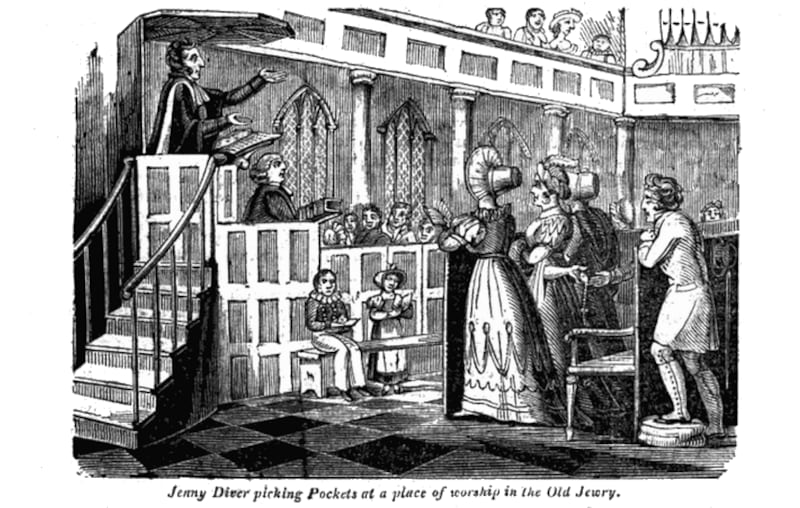Class inequality was a hallmark of 18th century society both in Ireland and overseas. Access to education was considered a luxury and only a small number of people, mainly men, would have been given the opportunity to attend school. For those without familial connections or a trade, poverty seemed inevitable. Yet those with an entrepreneurial spirit could occasionally break free from their prescribed paths in life and, if they were also willing to abandon some of their moral sensibilities, could also become quite wealthy. Mary Young was one such person.
Young's early life is clouded in mystery, though it is believed she was born in the north of Ireland as the child of a lady's maid and her employer. Her mother died soon after her birth and it appears she may have been initially raised in a brothel. At the age of 10 she was adopted by an elderly gentlewoman who took it upon herself to provide her young charge with an education. Young learned to read and write, and she also became an excellent seamstress; in fact she was considered an excellent needle worker. Five years later she decided to leave Ireland for Liverpool where she intended to use her skill with a needle to support herself.
Her journey was financed by a young servant who was infatuated with her, so much so that he stole his employer’s gold pocket watch and a reasonably large sum of money in order to pay for their passage. The daring couple had barely crossed the Irish Sea before the young man was recognised, arrested and brought back to Ireland for trial. He would eventually be transported to a penal colony for life. Young fortuitously managed to escape and made her way to London.
It must have been a daunting prospect for the adolescent emigrant. Now alone, on the run and without any existing contacts or partners she was probably feeling isolated and desperate. Using the remainder of her money she managed to find a place to live and tried to support herself through her trade. Her landlady, Anne Murphy, was a fellow Irishwoman who also happened to be the head of a notorious gang of pickpockets. Young struggled to establish herself as a seamstress and Murphy offered to induct her into the gang. She accepted her invitation.

As the newest and most unskilled member of the gang, Young was charged with spiriting away recently stolen goods from the scene of the crime. Her associate would cut the pockets of wealthy society women and quickly pass the goods to Young, who waited nearby. Young would then blend into the surrounding crowds and return to the gang’s safe house. She tells us that her first successful haul was two diamond belt buckles and a gold watch, which fetched the princely sum of £70. Young’s share amounted to £10.50, the equivalent of three months wages for a skilled labourer. While the pay-out may have been significant, so were the risks. If arrested pickpockets could face the death penalty or at minimum transportation to a penal colony overseas, where mortality rates were often abysmal.
Nevertheless, Young found the lifestyle intoxicating and took to it with great enthusiasm. She trained relentlessly and proved so naturally gifted that within a couple of years she took Murphy's place as head of the gang. She adopted a number of aliases including "Jenny Diver," "Jenny Webb," and "Jenny Murphew" and often stated she was born in England to confuse her adversaries. She dictated the rules by which the other gang members would live and ensured money was put aside to support invalided or ailing gang members.
She proved to be extremely resourceful and creative in the methods she employed to relieve her prospective marks of their worldly goods. Notably, she would entice young men to return to her (often temporarily rented) lodgings, where after they had removed all of their clothing and valuables, a member of the gang would burst in, warning them of the impending return of Young’s husband. The fearful young man would hide underneath the bed while Young and her accomplice escaped with the gullible fellow’s belongings. Another popular trick was to put on a large dress, complete with fake arms, and feign pregnancy. Young would attend public events, principally church services and plays, where she would then use her own hands to pick the pockets of those nearby and hide the stolen goods within her dress or pass them to a nearby accomplice.

Eventually, Young became a victim of her own success and her 15 year career as London’s most successful pickpocket would come to an end in dramatic fashion. She became far too recognisable and when she was eventually caught in the act of picking the purse of a wealthy lady she was sentenced to death. Classed as a highway robber, she was hanged in Tyburn on the March 18th, 1741, alongside 18 others, at one of the largest public executions of the 18th century. She was thought to have only been in her late thirties. Her legend lived on long after her death and she inspired many imitators.
This Extraordinary Emigrants article was written by Nathan Mannion, senior curator of EPIC The Irish Emigration Museum in Dublin’s Docklands, an interactive museum that tells the story of how the Irish shaped and influenced the world.


















